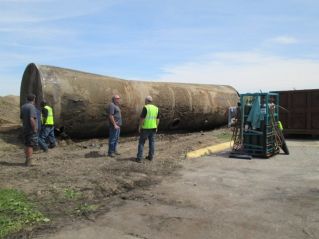Industrial/Commercial
.jpg?token=f42524507c0c47f9b3c9768126a09fcb)
.jpg?token=f42524507c0c47f9b3c9768126a09fcb)
.jpg?token=fa5a5176cc66c03a5f2cf8e7a4f28be2)
Vault Decommissioning
This project involved the decommissioning of a nickel hydroxide wastewater vault inside a facility that manufactures metal alloys.
The water and sludge within the vault were sampled, analyzed and removed and transported for disposal. The vault and drain lines were pressure washed and the rinsate was removed/disposed. The drain lines were plugged, the vault was filled with clean aggregate and capped with concrete. ECS documented the results in a Closeout Report. In addition, ECS conducted a subsurface investigation in the area of the vault and determined that no release to the environment had occurred. ECS also prepared a written professional opinion that the vault did not meet the definition of an Underground Storage Tank.

Underground Storage Tanks Removal, Leaking UST Assessment and Closure
2015-2021
This project involved the removal and subsequent closure of three leaking Underground Storage Tanks (LUSTs) from a charter air service facility within the Willow Run Airport.
ECS provided oversight of the decommissioning and removal of the fuel distribution system and jet fuel USTs (which consisted of two 30,000 gallon and one 20,000 gallon tanks). The tanks had leaked, impacting both soil and groundwater and it was determined that non-aqueous phase liquid (NAPL {essentially floating jet fuel}) was present.
Studies indicated that, over time, the groundwater contaminant plume and NAPL plume were stable or shrinking. ECS recorded a Restrictive Covenant that prohibited building structures in the source area due to potential volatilization to indoor air concerns. A Part 213 Closure Report was submitted to the Michigan Department of Environment, Great Lakes and Energy (EGLE) and subsequently approved.

ECS has provided services to numerous local, national, and international consulting firms. One example of this is a redevelopment project in Detroit, where a former commercial site was being redeveloped into multiple units of Permanent Supportive Housing (PSH) and emergency shelter for homeless adult women.
ECS conducted a NEPA Environmental Assessment which identified numerous on-site historical sources of potential contamination. We then directed the site characterization and remediation efforts and prepared a Baseline Environmental Assessment, a Response Activity Plan, a No Further Action Plan, a Documentation of Due Care Compliance and LUST reports including a Final Assessment Report, a Corrective Action Plan and a Closure Report. Finally, ECS completed a Vapor Intrusion (VI) Mitigation Pilot Study and designed the VI Mitigation system.
The ECS team also completed a SHPO Section 106 Application, a Cultural Resources Study Plan and a Phase I Archaeological Survey.
The results included HUD, SHPO, MSHDA and EGLE approvals and the project is currently under construction.
.jpg?token=f973d6dbf83416775122471c3535663c)
ECS has provided environmental due diligence (Phase I/II BEAs etc.,) building services (asbestos, lead based paint, mold, radon), USTs and vapor intrusion investigation/mitigation to many developers on high-profile properties. We have found that ECS is typically retained because we provide a broad array of consistent, high-quality services that deliver great value.
Some of the higher-profile properties in Southeast Michigan that ECS has provided services for include the Detroit Music Hall, Opus One, the Metropolitan Building, and numerous properties in the heart of the Eastern Market redevelopment district.